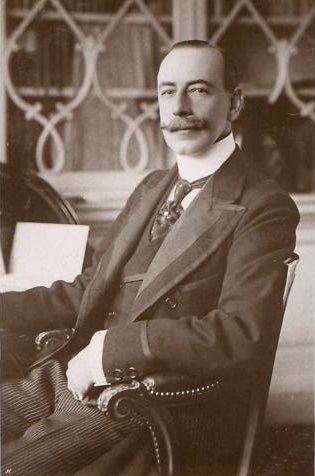Monarch Edward VIIGeorge V Prime Minister H. H. Asquith Resigned May 25, 1915 Monarch George V | Succeeded by The Earl Beauchamp Preceded by The Lord Windsor Name Lewis Harcourt, Children William Harcourt | |
 | ||
Prime Minister Sir Henry Campbell-BannermanH. H. Asquith Died February 24, 1922, Brook Street, London, United Kingdom Previous office Secretary of State for the Colonies (1910–1915) | ||
Lewis Vernon Harcourt, 1st Viscount Harcourt, PC (born Reginald Vernon Harcourt; 31 January 1863 – 24 February 1922) was a British Liberal Party politician who held the Cabinet post of Secretary of State for the Colonies from 1910 to 1915. Lord Harcourt's nickname was "Loulou".
Contents
- Family
- Political career
- Other public appointments
- Port Harcourt
- Lord Rosebery
- Queen Victoria
- Private life
- Marriage and children
- References
Family
Harcourt was born at Nuneham Courtenay, Oxfordshire, the only surviving son of politician Sir William Vernon Harcourt and his first wife Theresa Lister. He was originally christened with the name Reginald, in honour of his father's university friend Reginald Cholmondeley, but when George Cornewall Lewis died just over two months after, he was rechristened with the name Lewis. He never knew his mother who died only a day after giving birth to him. His elder brother, Julian Harcourt, had died the previous year. He was educated at Eton.
He inherited the lordships of the manor of Stanton Harcourt, Nuneham Courtenay, North Hinksey, Coggs, Northmoor and Shifford in Oxfordshire. He was also a Knight of Malta.
Political career
Harcourt was private secretary to his father, Sir William, as Home Secretary from 1880 to 1885. He was Liberal Member of Parliament for Rossendale, Lancashire, from 1904 to 1916 and served as First Commissioner of Works in Sir Henry Campbell-Bannerman's 1905 ministry (appointed to Cabinet in 1907) and to H. H. Asquith's Cabinet between 1908 and 1910 and again between 1915 and 1916. In this role he authorised the placement in Kensington Gardens of the Peter Pan statue, sculpted by George Frampton, erected on 1 May 1912.
Between 1910 and 1915 he was Secretary of State for the Colonies under Asquith. Harcourt received an Honorary DCL from Oxford University, and was raised to the peerage as Viscount Harcourt, of Stanton Harcourt in the County of Oxford, in 1917.
During the debate over Chancellor David Lloyd George's proposed "People's Budget" Harcourt was amongst its foremost critics, with Roy Jenkins noting that he was “the most inveterate in obstructing his proposals, while posing all the time as an ardent Radical.”
Other public appointments
Harcourt acted as a Trustee of the British Museum, Wallace Collection, the London Museum, and the National Portrait Gallery, which has a portrait of him.
Port Harcourt
Port Harcourt, capital of Rivers State in southern Nigeria, is named after him. When the port was established in 1912, there was much controversy about the name it should receive. In August 1913, the Governor-General of Nigeria, Sir Frederick Lugard wrote to Harcourt, then Secretary of State for the Colonies, "in the absence of any convenient local name, I would respectfully ask your permission to call this Port Harcourt", to which the Secretary of State replied, "It gives me pleasure to accede to your suggestion that my name should be associated with the new Port."
Lord Rosebery
Archibald Primrose, 5th Earl of Rosebery served as Liberal Prime Minister from 1894–1895 (after William Ewart Gladstone's fourth term and before Lord Salisbury's third). His main rival was Harcourt's father William. Loulou's attempts to have his father appointed were so fervent that many Liberal politicians criticised him. He helped to wreck Rosebery's administration, wrongly believing that his father would then succeed to the premiership. However, the Liberal Party was instead thrown into opposition for 10 years, and Harcourt was despised by Lord Rosebery for the remainder of his life.
Queen Victoria
Harcourt's diaries contain a report that one of Queen Victoria's chaplains, Revd Norman Macleod, made a deathbed confession repenting of his action in presiding over Queen Victoria's marriage to her servant, John Brown. Little credence is given to this report, in view of the many years which would have passed from the time of the "marriage" until Harcourt recorded it.
Private life
Harcourt was known as a sexual predator attracted to both sexes. He attempted to rape Dorothy Brett, the daughter of Lord Esher, and followed this by an attempt to seduce his son. Dorothy Brett wrote of him that "it is so tiresome that Loulou is such an old roué. He is as bad with boys as with girls ... he is simply a sex maniac. It isn't that he is in love. It is just ungovernable Sex desire for both sexes". His criminal perversion was known and tolerated in certain private quarters. After, however, he attempted to rape a 12-year-old boy (Edward James, who grew up to become a great collector of surrealist and other contemporary art), the boy's mother began making the matter public. Faced with public exposure, Harcourt committed suicide by taking an overdose of a sedative at his London home in Brook Street on 24 February 1922, aged 59.
Marriage and children
On 1 July 1899, Harcourt married Mary Ethel, daughter of Anglo-American banker Walter Hayes Burns and his wife Mary Lyman (née Morgan), a sister of J.P. Morgan. Through her, the family acquired the famous 'Harcourt emeralds'.
His wife Mary, Viscountess Harcourt, was appointed a Lady of Grace of the Order of St John and then Dame Grand Cross of the Order of the British Empire (GBE) in 1918; she died 7 January 1961.
Lord and Lady Harcourt had four children:
